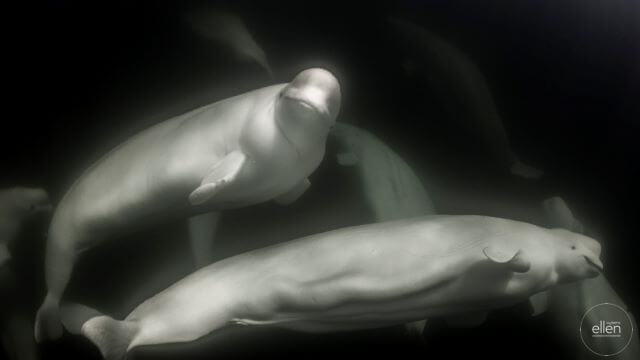Many people refer to belugas as “the canaries of the ocean” because of all the remarkable chirps, squawks and other weird and wonderful sounds they make. But now it may be time to add another term to how we describe them: the ocean’s “social butterflies.”
Although we’ve known for a long time that belugas are very gregarious and often congregate in crowds that number into the hundreds, a new study shows they have an even more complex social life than we had imagined. And it’s one that’s more similar to human social relationships than we’ve seen among other cetaceans (whales and dolphins).

They have an even more complex social life than we imagined. Photo ©Ellen Cuylaerts.
Despite not looking anything like us and living in a fully aquatic environment, belugas actually share a number of interesting characteristics with humans. They have big brains that are much larger than expected for their body weight; they have a complex communication system; they develop over a very prolonged juvenile (childhood) period; they have their own cultural traditions; and they experience menopause (older females stop reproducing themselves in order to participate in the care of their grandchildren).
In most highly social cetacean species that have been studied – e.g., sperm whales, orcas and pilot whales – cultural practices are passed along from generation to generation primarily through the matriline, i.e., among genetically related females. Therefore, groups tend to be composed of closely related females with the mother-calf dyad central to the group.
But in this new study, led by marine mammal scientist Greg O’Corry-Crowe at Florida Atlantic University, the researchers found that beluga whale groupings are not always based on genetic affiliation. Beluga whales form much more fluid kinds of aggregations, with individuals coming and going among other pods and families and then coming back together over space and time.
In other words, beluga whales have friends.Perhaps most notably, the researchers found that belugas have long-term relationships with other beluga whales who are not family members. In other words, they have friends.
The scientists examined beluga whale groups from ten locations across the globe, including the waters of Russia, Norway, Canada, Alaska and the Arctic, using a combination of observational methods and molecular genetic techniques to uncover the details of how beluga whales associate with each other.
“Unlike killer and pilot whales, and like some human societies, beluga whales don’t solely or even primarily interact and associate with close kin,” O’Correy-Crowe told Salon in a recent interview. “Across a wide variety of habitats and among both migratory and resident populations, they form communities of individuals of all ages and both sexes that regularly number in the hundreds and possibly the thousands.”
Like us humans, belugas don’t spend all of their time with their parents or siblings. Instead, they like to “hang out” with friends of all ages and sexes.
These discoveries have compelling implications for how and why groups form in mammals. Current theories about mammalian social evolution are based largely on what scientists believed to be the central importance of the matriline and the importance of staying with your genetic kin (known as inclusive fitness). But the new study turns these ideas on their head. The observations suggest that beluga whale groups may form for purposes of cooperation and collaboration across individuals who are not necessarily relatives, leading to conditions that may drive cultural innovation (again, as in human societies).
So, while belugas are known for their intelligence, communication skills, curiosity and social networking, field studies of what belugas do in their natural environment are revealing far more complexity than we previously thought.
And it’s worth bearing in mind that studies like these, conducted over thousands of miles of the ocean, are giving us the kinds of amazing insights that can never be gleaned from whales in captivity.